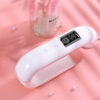HIFU
What is the difference between HIFU and RF (radio frequency)? Which should you choose?
Table of contents
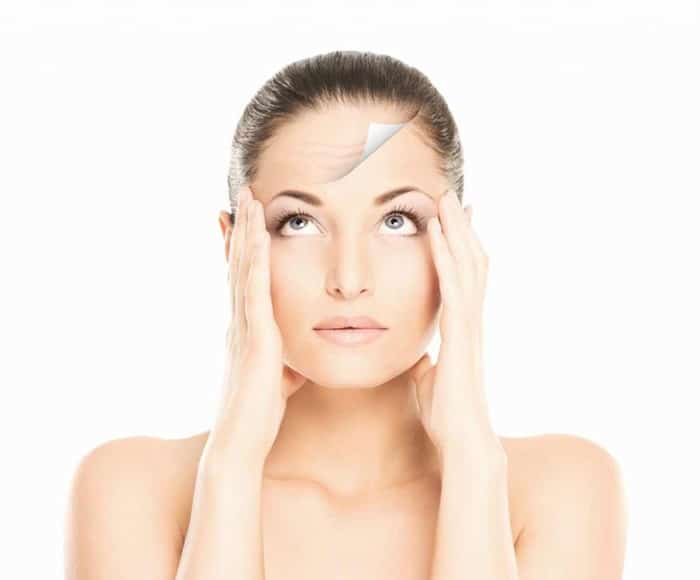

What exactly is the difference HIFU and RF?
New technology has led to a variety of methods to combat the signs of aging. But what is the most effective method you should choose?
As we age, our skin begins to lose its elasticity and youthful glow, which can make you look older than you are. Wrinkles are a natural part of getting older, and there is nothing terrible about having them. But while you should always embrace and love your skin and body at any age, you don't have to feel bad about holding on to some youthful perks.
After all, there is no vanity in wanting to look more attractive. So if you want to reduce the signs of aging in your face we have good news for you. There are safe and cost-effective alternatives that are not just about surgical procedures or skin care products.
By playing your cards right and carefully choosing treatment, you can effectively manage the signs of aging in a non-invasive way.
Choice of face rejuvenation method
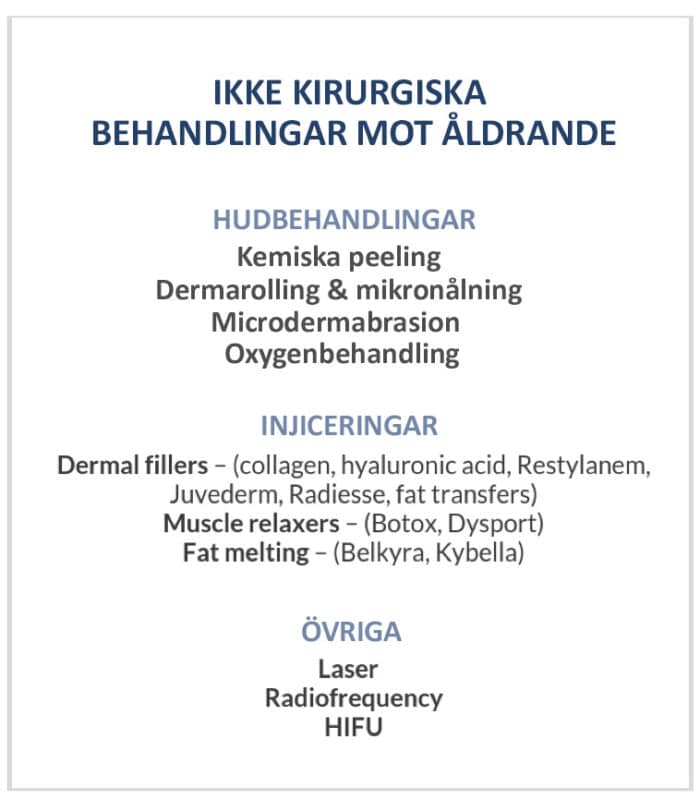

Modern technology gives us a wide range of treatments for facial tightening and rejuvenation. Getting so many options sometimes makes it difficult to decide which treatment is right for you. If you have researched the subject, you have probably come across terms such as high-intensity focused ultrasound (HIFU) and radio frequency (RF).
RF and HIFU are some modern "inside" words that are often mentioned when talking about anti-aging. But do you know how RF and HIFU differ from each other and how exactly can they help restore youthful skin?
RF and HIFU
Basically, both, HIFU and RF are non-surgical, non-invasive skin tension treatments that warm the skin and underlying tissues to stimulate its own collagen in its deep layers.
Although they both reduce loose skin and wrinkles they use different techniques to do so. In some cases, one method may be more appropriate than the other.
To help you make a wiser decision when choosing between HIFU and RF treatment, we give you some facts about each method to later compare them and give you more specific recommendations.
But before we discuss how to choose between RF and HIFU, it is important to understand the physiology of the skin to know what happens to it as we age.
How the face ages
While most people think about wrinkles as the primary manifestation of facial aging, the reality is much more complex. The aging process affects the entire facial structure, including skin, subcutaneous fat, muscles and facial bones.
Understanding the aging process and knowing how each face part (skin, fat, bone) changes over time allows you to decide which combination of treatments is best for achieving optimal results. So first, let's get to the bottom of what happens to our faces as we age.
Facial structures affected by aging
Signs of aging are cumulative effects, fat transfer, changes in bone tissue, degradation of collagen and elastin fibers.
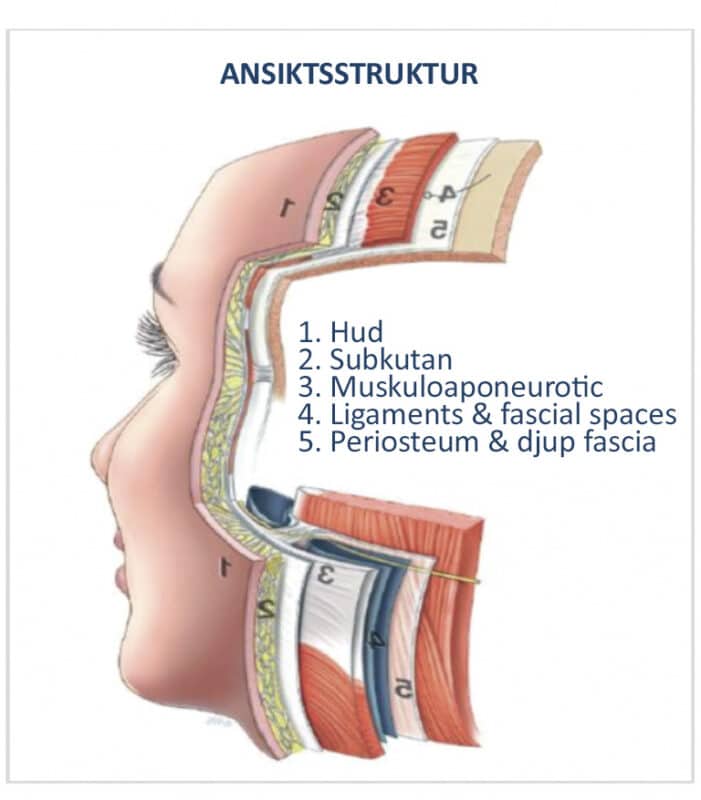

Our faces change mainly due to the modification of soft tissue and the fat component. The number of collagen fibers decreases and the remaining ones become disorganized. As the tissue weakens, it stretches, becomes more prone to wrinkles, sagging and fine lines deepen.
Due to chronic exposure to gravity, facial fat descends to the lower part of the the face. As a result, the skin loses its support and cavities that cause the face seems to have dropped. The skin and fat that migrates downward herniates under the jaw and behind the chin strengthening the hanging effect.
The aging processes do not end with the skin
But the aging process does not end with the skin and its fat layer. Although it may seem that the bony component of the face remains relatively stable, it also changes over time. The bone structure does not build itself. Thus, over time we can see an overall and gradual reduction in mass that causes differences in facial shape. This loss of support makes the cheekbones and nose appear more prominent. And combined with the effects of ongoing hollowing and sagging, it improves the visibility of fine lines and wrinkles.
Since the majority of the non-surgical facial rejuvenation methods do not work under the skin tissues, we will take a closer look at the skin and the aging process that takes place in the skin layers.
Different layers of skin
The skin consists of three layers: the outer layer (epidermis), the middle layer (dermis) and the deepest layer (hypodermis). Although skin cell renewal occurs within the deeper layers (with new skin cells moving outward toward the epidermis), each skin layer has an important function.
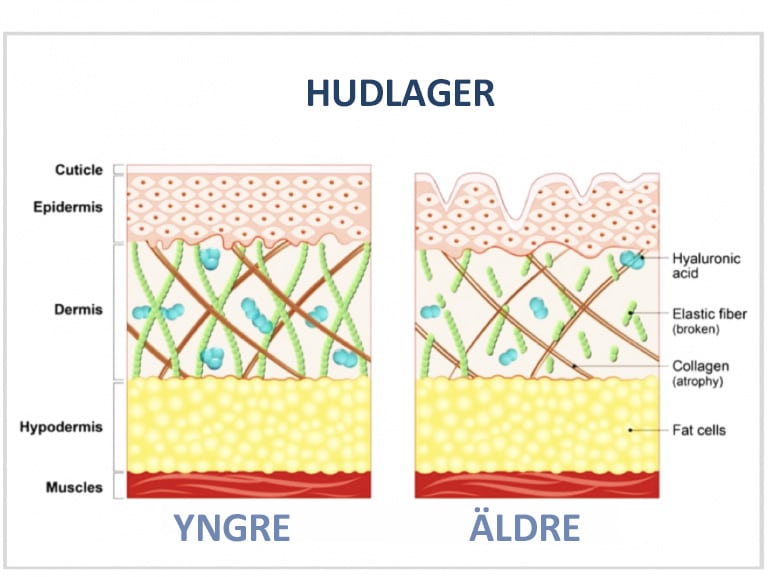

The outer layer contains pigment which is our natural protection against sun-induced skin damage. Dermis contains collagen and elastin - two proteins that are necessary for the health of the skin and which provide energy and nutrition to the epidermis. The hypodermis, which holds the protective layer of fat and the sweat glands, has insulating and moisturizing functions.
Each layer also contains connective tissue with collagen fibers that provide the support required for the skin's flexibility and strength. But what is the collagen you might be wondering? This worm-like component makes up 75% of your skin and lives in lower dermis levels. You can think of collagen as a frame or structure that provides strength and foundation for the rest of your skin. When you smile or frown (with the help of elastin), your skin returns to its original structure thanks to collagen.
Age-dependent changes in skin layers
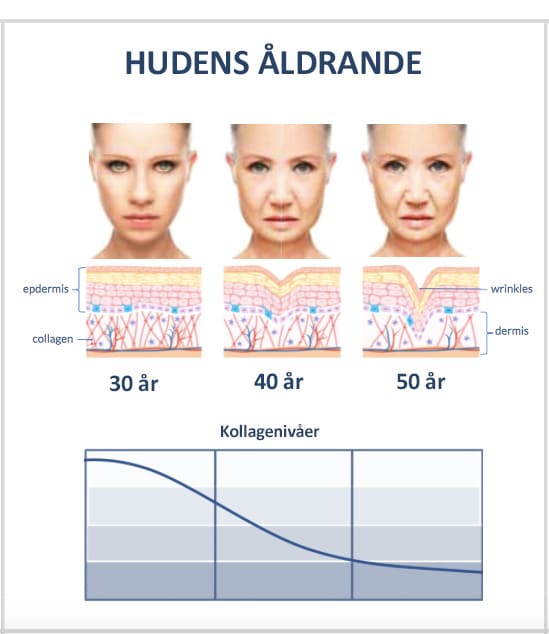
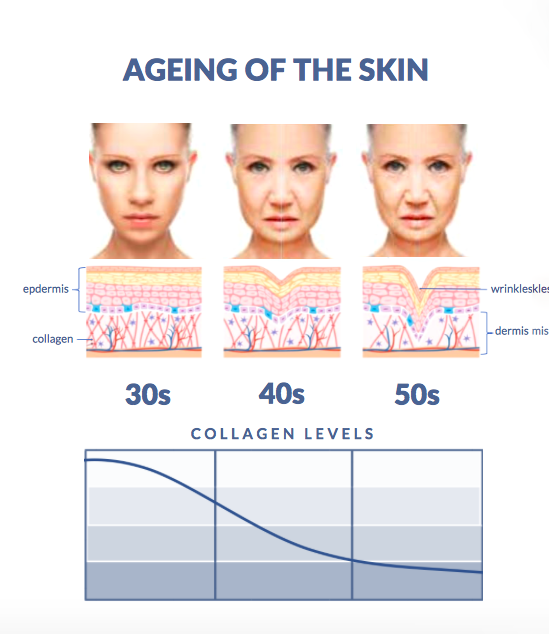
With age, the outer skin layer (epidermis) thins out and becomes lighter and transparent. In fact, pigmented spots cause the sun to appear. In addition, between the ages of 30 and 80, the rate of epidermal turnover in our cells is reduced by approximately 30 - 50%. This slowdown in cell turnover accounts for the characteristic and rough skin surface seen in older skin. Consequently, it becomes more fragile so that frequent rubbing and pulling can easily cause skin tears.
The majority of age-related changes that occur in our skin occur in its intermediate layer. Due to aging and environmental factors, collagen and elastin decrease over time. And lack of them causes the skin to wrinkle and sag.
Gradual decrease in collagen
Gradual reduction of collagen and elastin produced at a lower rate affects the skin's ability to repair itself. In fact, the dermis 20 – 80% loses its thickness during the aging process. This in turn lengthens the time it takes for the skin to return to its original position when stretched or pulled. The decrease in collagen and elastin proteins together with an extensive barrier layer in the epidermis is likely to cause dehydration and loss of turgidity. Resulting in additional hanging face and loss of elasticity.
As we age, we lose some of the fat under the outer layers of the skin. As a result, the hypodermis also begins to thin and contributes to a loss of structure that holds up the skin. This can cause the blood vessels just below the surface to look more prominent and your skin to look discolored. In addition, the sebaceous glands in the hypodermis produce less oil as you age (starting after menopause), making it harder to keep your skin moisturized. This increases the problem of dryness and itching, which increases the risk of skin damage.
Now that we understand a little better how events change in each layer of skin, we can take a closer look at their effects that we begin to see as we age.
Different signs of aging
As we get older, we suffer from the three main signs of aging: descent, deflation, and degeneration.
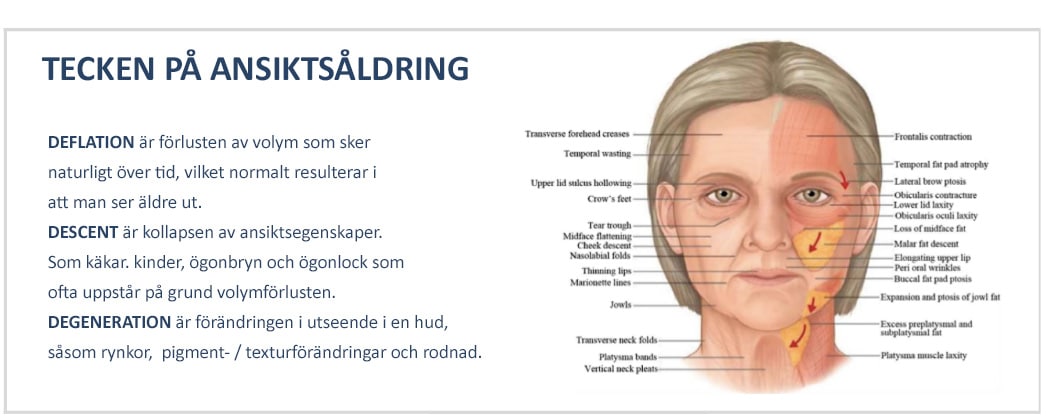

Hanging skin:
Facial pedigree is usually referred to as sagging skin. Salmon tissue and loose skin are most noticeable in sunken or hollow cheeks, and sagging skin under the jaw, creating a sagging appearance under the eyes and along the jaw. As a result of tissue degeneration as well as loss of collagen and elastin, the skin sinks and forms lines and wrinkles and accumulates in the lower part of the face.
Volume loss:
Deflation refers to loss of volume in the face, usually in the form of subcutaneous fat deposits that lose their support and sag. Over time, the fatty tissue, collagen and elastin begin to spin off. This makes our face becomes less firm.
Wrinkles:
Degeneration refers to a process in which our skin loses its tone and structure (age spots, hyperpigmentation and static wrinkles). It is caused by low levels of collagen and elastin - the building blocks of a firm, strong skin. Lack of these two elements tends to build up dead cells - causing a tired look - and the skin becomes more weathered, delicate and sensitive. Extrinsic factors such as diet, sun or exposure to impurities can also increase the skin's regeneration process.
HIFU Skin tightening
It is a new type of non-surgical, non-invasive method that uses ultrasound technology and the body's own natural healing process to tighten and tone facial skin.
Unlike ultrasound, which doctors use to image babies in the womb, uses HIFU treatment high-intensity focused ultrasonic waves. Their high concentration allows the technology to reach a certain point below the skin surface where it reaches the SMAS layer (muscle layer). HIFU works deep below the surface and stimulates the growth of collagen without damaging the outer layer of the skin.
This results in prolonged tightening and tightening of the skin after just one treatment.
How HIFU tightening of the skin works
A HIFU machine emits highly concentrated ultrasonic energy that is delivered deep into the skin and causes very precise thermal coagulation that reaches the SMAS layer. By delivering small deposits with focused ultrasonic energy, a specific place is heated in a short time.
Your skin responds to this energy by stimulating its deep skin tissue to produce new compact collagen fibers. This in turn leads to a gradual tightening and improvement of the skin's elasticity and firmness. As the skin tightens, wrinkles and lines become less visible. The structure of the skin improves when it becomes smooth, shiny and firm.
Expected results of HIFU tightening of the skin
Initial tightening of the skin can be seen immediately after the treatment, and it continues gradually over time. This means that with just one treatment, the regenerative process begins, but its complete results will develop over 2 - 3 months.
Radiofrequency Skin Tightening (RF)
RF skin tightening is dependent on devices that use radio frequency waves to convert energy from radio to heat. Energy produced in this way heats the deeper layers of the skin to stimulate the collagen regeneration response. The radio frequency used in these devices differs from that emitted by your microwave oven, mobile phone or radar equipment. Its low frequency is closely monitored to ensure that targeted tissues reach the optimum temperature to induce new collagen production and cell regeneration without overheating. In this way, it can safely penetrate to a deeper level of the skin, which helps to improve its tone and structure.
How does RF skin tightening work?
Radio frequency is one laser which treats the dermis, the middle layer of the skin, with concentrated heat. It penetrates no deeper than 3 mm into skin tissues selectively heating it to promote two types of responses. The deeper the penetration, the less impact the heat has and therefore this treatment has its limits. The emitted waves carry heat and energy deep into the skin, which has a positive effect on the lymphatic and vascular system by increasing the fluid flow through the cells.
Heating in this area, without damaging the outer layers of the skin, causes microscopic changes in the tissues and collagen contraction. This stimulates subsequent collagen production in the following months and results in immediate tightening of skin tissues. By improving the deep blood circulation, it also gives your skin a natural glow and improves the skin's brightness.
Expected results RF tightening
RF can be used with any skin color and is ideal for facial rejuvenation, reshaping and restoration of facial muscles, lifting the eyebrows and clearing the area around the eyes, improving wrinkles and fine lines. It is mainly used to treat weakness in the face by tightening the face, and it is best suited for clients with mild to moderate sagging facial tissue, usually between the ages of 30 and 50.
Collagen stimulation begins during treatment and continues for many months afterwards. For best results, you may need several sessions during the first few months and one or two sessions per year in order to maintain. However, the recommended frequency of sessions depends on the device used for the treatment.
Radio Frequency (RF) vs HIFU
Although both RF and HIFU have the same intention, these two methods are quite different and using one or the other depends entirely on the result you want to achieve. We have listed the most important differences to clarify the process and help you choose the treatment that best suits your needs.
Differences between Radio Frequency (RF) and HIFU
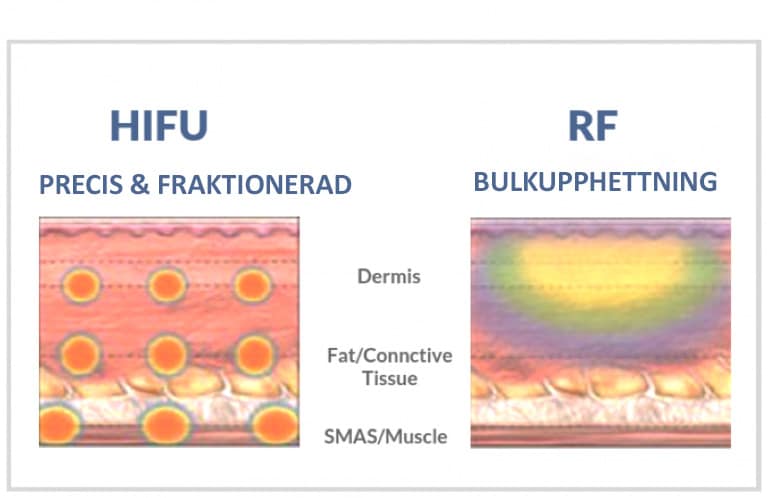

The first and the most obvious way in which they differ is that they use different techniques to warm up deep skin tissues. HIFU delivers more accurate and intense fractionated ultrasonic energy while RF based on a bulk heating strategy.
Second each technique works in different but partially overlapping skin layers. HIFU goes much deeper into and beyond the dermis and can reach the SMAS layer. RF, on the other hand, does not go as deep as HIFU. It focuses on epidermal layers and goes no further than the deep dermis.
For the third, while HIFU is generally performed as a single treatment, RF may require multiple sessions. The need for the number of treatments depends on the type of device used and your skin conditions, such as its current elasticity or your genetic inheritance.
For the fourth The use of ultrasonic energy in cosmetic procedures is a relatively new method. So when it comes to aesthetic facial rejuvenation, RF has been around much longer.
How to choose between HIFU and RF?
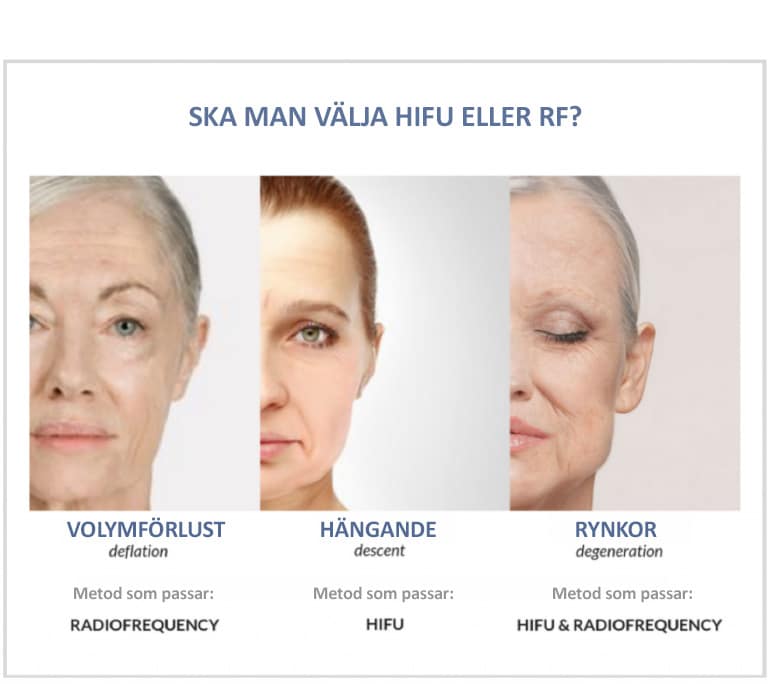

As we age, our face begins to show a mixture of sagging skin and wrinkles. Although each person's aging style is always unique and should always be treated individually, the following guide explains how different treatments may be more appropriate for different types of problems.
Om ditt huvudproblem är hängande och ditt slutmål är ”lyft” -effekt kan det vara en bättre idé för dig att använda HIFU. Djupet av dess vävnadsstramning möjliggör mer framträdande resultat. HIFU är det bästa valet för att dra åt lös hud runt mun och käke, förbättra utseendet på en dubbel haka eller ”lyfta” ögonbrynen.
RF does not penetrate as deep into the skin as HIFU
RF is a less intensive method that penetrates tissues but not as deep as HIFU and may be a better choice for managing volume loss or for treating sensitive areas such as the lower and upper eyelids. If you have no or limited skin laxity but have lost face volume, you can choose RF. It will tighten the skin but also create an effect of more volume, especially in the area around the mouth.
Both HIFU and RF increase collagen production and accelerate the reshaping of skin tissues. They are both effective in treating wrinkles and fine lines. The best method to treat the signs of skin degeneration depends on the extent of your skin aging and the area you want to treat.
Where can you get HIFU and RF treatment?
As with all aesthetic procedures, the results of either HIFU or RF are based on the effectiveness of the device you use. At Vivre® we have developed a device that is the first to be CE marked and approved in the EU and that combines both HIFU and RF in a single machine. In addition, VIVRE® HIFU / RF PREMIUM developed to be used at home easily and safely.
Complementary ways to delay aging
Both HIFU and RF retract the aging clock, but they do not stop the aging process. Deciding on any of these treatments will certainly restore the firmness of the skin but you will continue to age in any case - unfortunately. Yet not all the changes we see on our faces are caused by the inevitable aging. Many of them are the result of external lifestyle and environmental factors such as sun damage, smoking, allergens, toxins, stress, pollution and pesticides.


